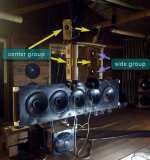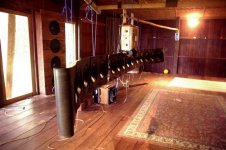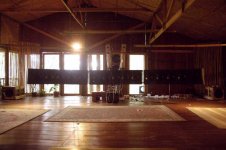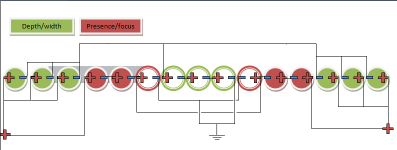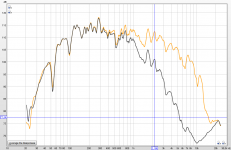Something I've been trying to work out in my head: If one wants to do a really minimalist full-spectrum SSS - using just 3 speakers and 2 channels of amplification, how do we deal with the bass?
I've got some bass-capable coaxes that I want to try SSS . . .
It seems that the L vs R level and phase shifts would make bass very challenging. 3 drivers won't play together well in a common bass enclosure. Creating a (non-matrixed) Lowpass and successful highpass into a matrix would get pretty complicated due to interaction thru the passive crossover region, etc.
Would everything work just fine if we make M = .33 in the bass range? , L-R bass is rarely very far out of phase on most recordings . . .
Waiting for a 'light bulb'in my head to come on,
-- Mark
I think there is no problem with the bass using the matrix x = 0.5. What problems are you seeing ?
If L and R signals are opposite phase, then due to matrix the center element is mute and side elements are in opposite phase working as a dipole, and in this case there is no pressure change inside the box.
More generally, I think we should look what is the ideal bass reproduction method in the small room acoustic space overall. I have found that dipole bass is very good. Thus I'm using separate dipole bass due to its performance in a small room rather than trying to minimalise the design at this point.
One certainly could design a true single speaker stereo by integrating the bass elements at the base and use a matrix. In this case there is a need for two matrixes (in a two way system). The cross over filter should be installed at the entrance points of the matrix.
I have plans to try the bass matrix as well.
- Elias
What do you mean by "ideal center of one's position" ?
The location of SSs is not a problem, I have experimented placements in various configurations. It works when placed on the front wall and also 1 m from the front wall. I also succesfully placed it above a TV set.
- Elias
By "ideal center of one's position" I was referring to the need to have the sound balanced to one's ears. And generally that might be a placement which is centered in front of the listener. In most cases this would be near the wall, where the sound would be radiated to the left for the left speaker and to the right for the right speaker. It would radiate outward from the perpendicular walls and add depth, but still a sense of left and right channel.
If the speaker is placed off center, with all things considered, the sound may well be weighed to one side. The speakers could also be brought out into the room, but that would not be practical in most cases.
Also, could you show us a picture of the speaker placed above the TV set? I'd have to see that one. And I am assuming you are not married. Is that correct? Since you state that it was placed 'above' and not 'on top of' the TV, it is either sitting on a shelving unit, platform, or suspended from above? I am having trouble imagining this blending in with the room's other furniture.
My first impression concerning this type of project is that the low frequencies might best be fired downward. Low frequency sound is non-directional, and could be used like a subwoofer, radiating outward in all directions. That would leave the other two channels to be shot out each side of the cabinet. And it could be used to radiate from the side walls, or have a 'diffraction lense' to immediately redirect the sound to the front.
If the bottom is used for low frequencies, the top section would not need to be in larger chambers, so as to bring the frequency response of those upper speakers down lower.
I hope I am making sense here. But that is what immediately came to mind as I envisioned how the cabinet would be made.
By "ideal center of one's position" I was referring to the need to have the sound balanced to one's ears. And generally that might be a placement which is centered in front of the listener. In most cases this would be near the wall, where the sound would be radiated to the left for the left speaker and to the right for the right speaker. It would radiate outward from the perpendicular walls and add depth, but still a sense of left and right channel.
If the speaker is placed off center, with all things considered, the sound may well be weighed to one side. The speakers could also be brought out into the room, but that would not be practical in most cases.
Also, could you show us a picture of the speaker placed above the TV set? I'd have to see that one. And I am assuming you are not married. Is that correct? Since you state that it was placed 'above' and not 'on top of' the TV, it is either sitting on a shelving unit, platform, or suspended from above? I am having trouble imagining this blending in with the room's other furniture.
My first impression concerning this type of project is that the low frequencies might best be fired downward. Low frequency sound is non-directional, and could be used like a subwoofer, radiating outward in all directions. That would leave the other two channels to be shot out each side of the cabinet. And it could be used to radiate from the side walls, or have a 'diffraction lense' to immediately redirect the sound to the front.
If the bottom is used for low frequencies, the top section would not need to be in larger chambers, so as to bring the frequency response of those upper speakers down lower.
I hope I am making sense here. But that is what immediately came to mind as I envisioned how the cabinet would be made.
Quite a few points you make.
The symmetrical room placement for the SSS and the listener is beneficial but not crusial. For example the lack of sweet spot allows lateral movements in the range of +/- 1 m in my 25 m2 room. Also, if the speaker cannot be placed on the symmetry line of the room, it can be compensated by moving the listening area to the opposite direction.
For the TV set you can see pics by clicking my signature and go to the loudspeakers area, or scroll back this thread for a few pages. Also another Diyaudio member Optic has been using SSS for a TV.
Directional properties at the low freq depends on the speaker. For example dipoles are directional down to DC. SSS is also directional at bass due to the vector steering of the matrix. The directionality depends on the recorded stereo material: If bass is mono in the recording, SSS reproduces it as absolute mono. If bass is coming from one stereo channel, SSS will aim the energy to that side.
For a practical construction integrating SSS bass, of course the bass elements should be placed in a separate enclosure. They should operate with their own matrix. Cross over connects the two matrixes together at the amplifier terminals. One stereo amplifier is enough for a passive implementation of a two way SSS.
- Elias
Not sure if this was posted before but here's another single speaker example: M-S SPEAKER SYSTEM
Not sure if this was posted before but here's another single speaker example: M-S SPEAKER SYSTEM
Yes it's quite old article already 20+ years. Despite of that I havent's heard or read anyone actually build it, or similar construction.
I think there is no problem with the bass using the matrix x = 0.5. What problems are you seeing ?
If L and R signals are opposite phase, then due to matrix the center element is mute and side elements are in opposite phase working as a dipole, and in this case there is no pressure change inside the box.
So far I haven't honestly experienced problems yet, as I'm yet using a subwoofer and my L-C-R speakers are in seperate enclosures. Like you point out, there are no problems 100% dipole (difference) signal. But this is a really rare event in recordings . . . so when using a shared enclosure where the phase and level of each driver is constantly changing - a ported enclosure would probably be out of the question.
I have found that dipole bass is very good. Thus I'm using separate dipole bass due to its performance in a small room rather than trying to minimalise the design at this point.
I'm a fan of dipole bass as well, no problem there
I have plans to try the bass matrix as well.
Please do! Many thanks
 for sharing your ideas and findings.
for sharing your ideas and findings.-- Mark
Bass matrix ? I tried it (post 268).
The subject of the test consists of a composite sub : 4 x 15" in an IB, and 2 x 15" by side fitted in H frames. So the results of the test are already conditioned by a difference of efficiency relatively to the frequency as only the central element will produce something in the lowest octaves (it's able to do 20 Hz @ 0 dB).
Any sub is very hard to measure in a confined space. But once the correct repartition optimized, the only residual problem is a lot of combing effect of moderate amplitude while the normal set up shows something smoother.
Listening to it alone, the lateralization is more pronounced. This comes at a price, the lateral H frames are under higher duty. Once listened with the whole system, this improved lateralization weights nothing in front of the clues provided by the mid bass arrays ( Fc 100 Hz), and the only effect of the matrix subs is a reduction of the head room. So, back to the normality and it's ordinary pleasures..
The subject of the test consists of a composite sub : 4 x 15" in an IB, and 2 x 15" by side fitted in H frames. So the results of the test are already conditioned by a difference of efficiency relatively to the frequency as only the central element will produce something in the lowest octaves (it's able to do 20 Hz @ 0 dB).
Any sub is very hard to measure in a confined space. But once the correct repartition optimized, the only residual problem is a lot of combing effect of moderate amplitude while the normal set up shows something smoother.
Listening to it alone, the lateralization is more pronounced. This comes at a price, the lateral H frames are under higher duty. Once listened with the whole system, this improved lateralization weights nothing in front of the clues provided by the mid bass arrays ( Fc 100 Hz), and the only effect of the matrix subs is a reduction of the head room. So, back to the normality and it's ordinary pleasures..
I was focused on the bass and forget something more important.
I have extended the matrix wiring to the HF way and it's a very positive improvement. This goes against Gerzon's statements and more modestly against my findings when testing on the mids arrays.
The central speaker is made with two old dynaudio D54 domes in parallel. Like this, they miss the upper octaves, the D54 cuts after 8000, this sounds unbalanced. When joining to them a couple of high passed 1", it gets much better.
Not because supposed improvements of space rendering, but because it simply sounds obviously more natural. I have also seen this phenomenon with the mids, somebody can explain that ?
I have extended the matrix wiring to the HF way and it's a very positive improvement. This goes against Gerzon's statements and more modestly against my findings when testing on the mids arrays.
The central speaker is made with two old dynaudio D54 domes in parallel. Like this, they miss the upper octaves, the D54 cuts after 8000, this sounds unbalanced. When joining to them a couple of high passed 1", it gets much better.
Not because supposed improvements of space rendering, but because it simply sounds obviously more natural. I have also seen this phenomenon with the mids, somebody can explain that ?
Attachments
My comment wasn't meant to stop anybody from experimenting. I believe it's very important to try and hear as many things as possible. The problem is that in audio many people jump to conclusions way too early. Audio reproduction is not some kind of magic, it's solely a technical process.
Bass matrix ? I tried it (post 268).
The subject of the test consists of a composite sub : 4 x 15" in an IB, and 2 x 15" by side fitted in H frames.
...
But once the correct repartition optimized, the only residual problem is a lot of combing effect of moderate amplitude while the normal set up shows something smoother.
Oh yes. Matrix on a distributed placement of speakers.
The combing effect is propably for that reason too ? If the wave would be launched from a singular point, no combing from the speakers at the listening position.
You don't happen to have 3 closed box bass speakers ?
- Elias
I have extended the matrix wiring to the HF way and it's a very positive improvement. This goes against Gerzon's statements and more modestly against my findings when testing on the mids arrays.
Gerzon did make quite a lot of statements (many of them still holds)
- Elias
So far I haven't honestly experienced problems yet, as I'm yet using a subwoofer and my L-C-R speakers are in seperate enclosures. Like you point out, there are no problems 100% dipole (difference) signal. But this is a really rare event in recordings . . . so when using a shared enclosure where the phase and level of each driver is constantly changing - a ported enclosure would probably be out of the question.
I'm a fan of dipole bass as well, no problem there!
Please do! Many thanksfor sharing your ideas and findings.
-- Mark
If we take a look on the graph (from my home page) about signaling of the matrix x = 0.5 it can be seen the low freq directivity pattern will depend on the stereo L and R signals, and that it will undergo a transformation from a monopole (L = 1, R = 1) to a dipole (L = -1, R = 1). This can only happen if it goes through a cardioid as well. When under the cardioid pattern, energy is directed primarly to one direction towards side wall where it is reflected to the listening position.
An externally hosted image should be here but it was not working when we last tested it.
My earlier hypothesis was if there is a need to compensate the dipole roll off with the help of a separate MS matrix (see earlier in this thread). Until I experiment with a bass matrix from a singular point, I cannot conclude if the compensation is needed or not.
- Elias
Hi Elias,
The Gerzon statement is unfortunately a second hand one (post 273), but from a (hopefully) trustable source.
About my bass experience conclusions, it's only specific to my system. It's done with very different speakers that were not intended for this. Their respective efficiencies are not the same towards the reproduced band (IB = lower octaves, H Frames = higher). Worse, their impedances have a ratio of 8 ( 2 Ohms for IB, 16 Ohms for H, if I don't do this I don't hear the IB).
So, you really have to make your own with compatible drivers, from a single point, it must be very interesting.
While this project and the original topic "from a single box", I stay persuaded that a distribution inspired from the OSD style is a good option with this matrix. It means a wide circle arc : tweeters in the center, bass at the other extremity and mids in between. A precision : side firing tweeters, you must remember why.
PS : no sealed or ported enclosure in this house, It's too complicated to do.
The Gerzon statement is unfortunately a second hand one (post 273), but from a (hopefully) trustable source.
About my bass experience conclusions, it's only specific to my system. It's done with very different speakers that were not intended for this. Their respective efficiencies are not the same towards the reproduced band (IB = lower octaves, H Frames = higher). Worse, their impedances have a ratio of 8 ( 2 Ohms for IB, 16 Ohms for H, if I don't do this I don't hear the IB).
So, you really have to make your own with compatible drivers, from a single point, it must be very interesting.
While this project and the original topic "from a single box", I stay persuaded that a distribution inspired from the OSD style is a good option with this matrix. It means a wide circle arc : tweeters in the center, bass at the other extremity and mids in between. A precision : side firing tweeters, you must remember why.
PS : no sealed or ported enclosure in this house, It's too complicated to do.
The Gerzon statement is unfortunately a second hand one (post 273), but from a (hopefully) trustable source.
I believe that source can be trusted
- Elias
Next step for me and now in topic because it's (almost) from a single loudspeaker following Elias's definition.
Interestingly a "traditional" mapping with L-C-R banks does'nt give as good results than the vertical arrays. But my plan was to try some other combinations, this becoming possible when using many drivers (but I will add more).
Here just a wiring sample between maybe one hundred possible variants, without even thinking of delays or curvatures. Arbitrarily the green an red groups have some optimistic names, but it's close to the reality. This is done by the relative impedances and efficiencies. Elementary, but it works already pretty well for a new born.
Interestingly a "traditional" mapping with L-C-R banks does'nt give as good results than the vertical arrays. But my plan was to try some other combinations, this becoming possible when using many drivers (but I will add more).
Here just a wiring sample between maybe one hundred possible variants, without even thinking of delays or curvatures. Arbitrarily the green an red groups have some optimistic names, but it's close to the reality. This is done by the relative impedances and efficiencies. Elementary, but it works already pretty well for a new born.
Attachments
15 12inchers array in a 'single' loudspeaker, and you called that 'elementary' ?! 
So, now I may see this monster as 2 sets of overlapping SSS. By intuition, it might be preferable to arrange the one with larger x on both ends and midway (between center and side); and a smaller x to the other set for the center and slightly inward side units.
Does that make sense?
OTOH, this might conflict with the doable wiring scheme under the considerations of x factor and SPL distributions. Delimmas everywhere, as always.
Already mega impressive anyway. And it's a large playground (both in space and this platform of array) for future development. I bet you'll have a lot of fun along this wonderful journey
So, now I may see this monster as 2 sets of overlapping SSS. By intuition, it might be preferable to arrange the one with larger x on both ends and midway (between center and side); and a smaller x to the other set for the center and slightly inward side units.
Does that make sense?
OTOH, this might conflict with the doable wiring scheme under the considerations of x factor and SPL distributions. Delimmas everywhere, as always.
Already mega impressive anyway. And it's a large playground (both in space and this platform of array) for future development. I bet you'll have a lot of fun along this wonderful journey
The principle itself is elementary, only one amp for the mids, no line circuit. It's better to keep the things simple for the early development as many usual old behaviors have changed. I dunno exactly yet what makes sense or not.
For instance there is a clear limit in the high pass of the mids : over it, some localisations clues are ambiguously on both sides when is only one side on the record. Under the limit it's suddenly OK and also becomes wider.
I join a plot where the optimal maximal curve shows a roll off after 1000 Hz. Has this something to do with the ITD/ILD transition ? Or more simply a directivity related issue ? Or something related to the mapping ? Or a reflection problem, as a too uniform floor bounce ?
For instance there is a clear limit in the high pass of the mids : over it, some localisations clues are ambiguously on both sides when is only one side on the record. Under the limit it's suddenly OK and also becomes wider.
I join a plot where the optimal maximal curve shows a roll off after 1000 Hz. Has this something to do with the ITD/ILD transition ? Or more simply a directivity related issue ? Or something related to the mapping ? Or a reflection problem, as a too uniform floor bounce ?
Attachments
- Home
- Loudspeakers
- Multi-Way
- Stereophonic Sound from a Single Loudspeaker
